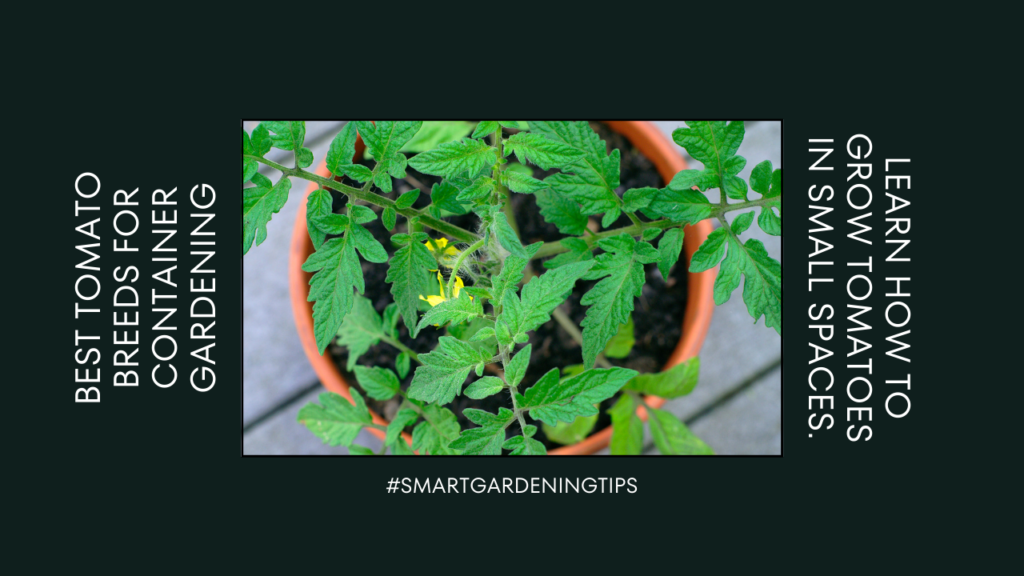
Welcome to our article on the best container tomato breeds for growing in limited spaces. If you have a small patio or balcony, you can still enjoy delicious homegrown tomatoes right at your doorstep. With these compact tomato varieties, container gardening has never been easier or more rewarding!
Key Takeaways:
- Container gardening allows you to grow tomatoes in small spaces like patios and balconies.
- Compact tomato varieties are specifically suited for container gardening.
- By choosing the right tomato breeds, you can enjoy a bountiful harvest in limited spaces.
- Container tomatoes require proper care, including ideal growing conditions and maintenance techniques.
- With the right knowledge and techniques, you can successfully grow your own tomatoes in containers.
Early Girl Tomato: Ideal Growing Conditions
The Early Girl tomato is a popular choice for container gardening due to its early maturity and compact size. With the right growing conditions, you can enjoy a bountiful harvest of these delicious tomatoes right on your patio or balcony. In this section, we will discuss the optimal growing conditions for the Early Girl tomato, ensuring that you have success with this variety.
Sunlight Requirements
The Early Girl tomato thrives in full sunlight, requiring at least 6-8 hours of direct sunlight each day. When choosing a location for your container, select a spot that receives ample sunlight throughout the day. This will promote healthy growth and help the tomatoes develop their signature flavor.
Soil Type
To provide the ideal growing environment for Early Girl tomatoes, use a well-draining soil mix that is rich in organic matter. A mixture of compost, peat moss, and perlite is recommended. This will ensure good drainage, prevent waterlogged roots, and supply the necessary nutrients for robust plant development.
Watering Practices
Proper watering is crucial for the success of your Early Girl tomatoes. Keep the soil consistently moist but not waterlogged.
Remember, tomatoes generally require more water during hot, dry weather.
Monitor the moisture levels and water as needed, aiming to keep the soil evenly moist. Avoid overhead watering, as this can lead to diseases and cause the foliage to stay wet for extended periods. Instead, gently water at the base of the plants to ensure the water reaches the roots.
Optimal Temperature Range
The Early Girl tomato flourishes in moderate temperatures, ideally between 65°F and 85°F (18°C and 29°C). Temperatures above 90°F (32°C) can inhibit fruit set and impact overall plant health. If you live in an area with hot summers, consider providing shade or using a shade cloth to protect your plants from excessive heat.
Fertilization
To support vigorous growth and abundant fruit production, fertilize your Early Girl tomatoes regularly. Apply a balanced, slow-release fertilizer according to the package instructions. Organic options such as compost or well-aged manure can also be used to nourish the plants. Be careful not to over-fertilize, as this can lead to excessive foliage growth at the expense of fruit development.
Spacing
When growing Early Girl tomatoes in containers, it’s important to provide adequate spacing for each plant. A general guideline is to plant one Early Girl tomato per 5-gallon (19-liter) container. This allows enough room for the roots to spread and ensures proper air circulation, reducing the risk of diseases.
Remember to provide support for your Early Girl tomato plants, such as stakes or cages, to keep them upright as they grow.
By providing the Early Girl tomato with the ideal growing conditions, you set the stage for a successful container garden. Follow these guidelines, and you’ll be able to savor the delicious taste of homegrown tomatoes in no time.
Next, we will explore the harvesting and storage tips for your Early Girl tomatoes. Get ready to enjoy the fruits of your labor!
Early Girl Tomato: Harvesting and Storage Tips
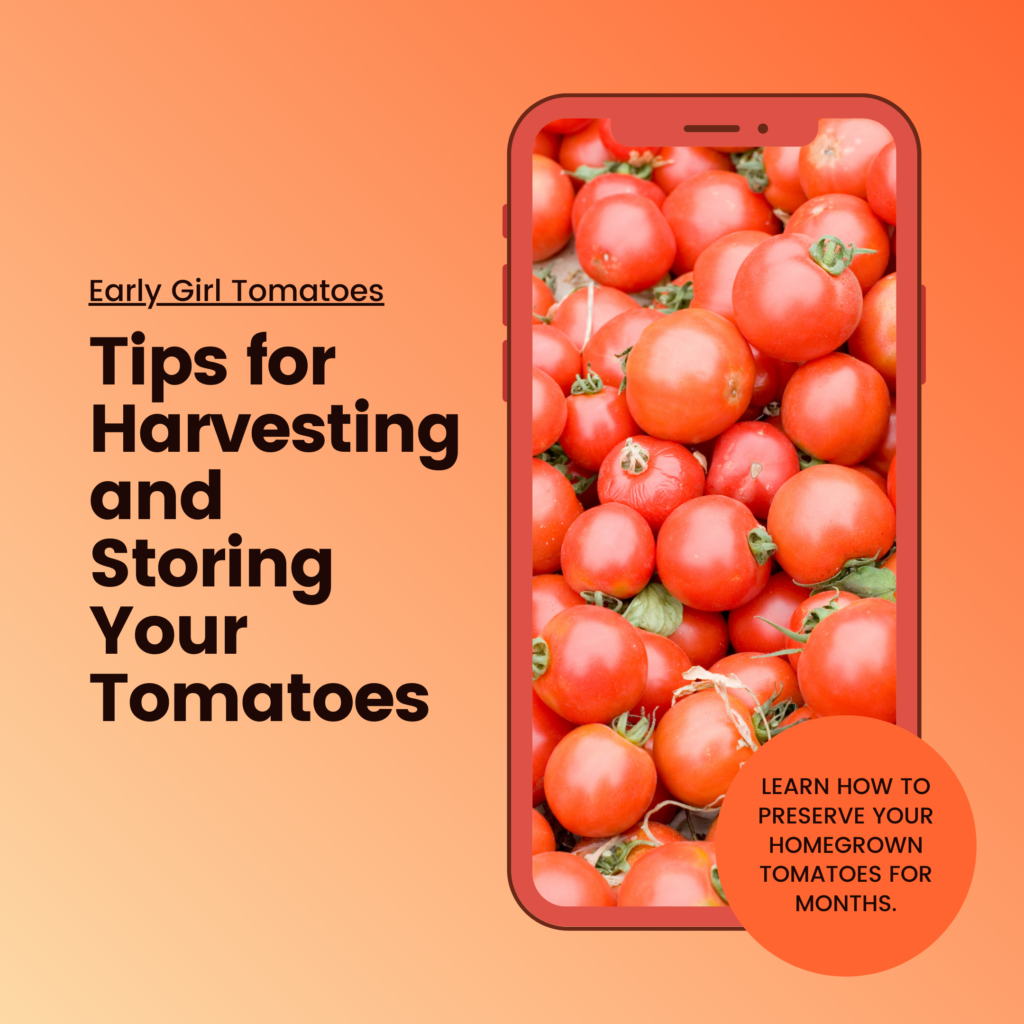
Once your Early Girl tomatoes have ripened, it’s important to harvest them at the right time to ensure maximum flavor and freshness. Follow these tips on how to properly harvest and store your Early Girl tomatoes for long-lasting enjoyment:
- Wait until the tomatoes are fully ripe before harvesting. They should be firm but slightly soft to the touch with a deep red color.
- To harvest, gently twist or cut the tomato stem with a sharp pair of pruning shears, leaving a small portion of the stem attached to the fruit.
- Avoid pulling or tugging on the tomatoes, as this can damage the fruit and reduce its shelf life.
- Inspect each tomato for any signs of bruising, rot, or disease. Remove any damaged tomatoes from the harvest.
- Once harvested, gently wash the tomatoes with cool water to remove any dirt or debris from the surface. Allow them to air dry completely.
To extend the shelf life of your Early Girl tomatoes, it’s important to store them properly:
- To store tomatoes at room temperature, place them in a single layer in a well-ventilated area, away from direct sunlight. Avoid storing them in plastic bags, as this can trap moisture and cause them to spoil quickly.
- If you have a large harvest and need to store the tomatoes for a longer period, consider refrigeration. To refrigerate your tomatoes, place them in a paper bag or cardboard box and store them in the vegetable drawer. This will help maintain their freshness and extend their shelf life for up to a week.
- It’s important to note that refrigeration can affect the flavor and texture of tomatoes, so it’s best to consume refrigerated tomatoes within a few days.
Remember, the key to enjoying the full flavor of your Early Girl tomatoes is to harvest them at their peak and store them properly. By following these tips, you can savor the delicious taste of homegrown tomatoes for an extended period.
Recommended Storage Times for Early Girl Tomatoes
To help you keep track of your tomato storage, here are the recommended storage times for Early Girl tomatoes:
| Storage Method | Recommended Storage Time |
|---|---|
| Room Temperature | 3-5 days |
| Refrigeration | Up to 1 week |
Brandywine Tomato Characteristics
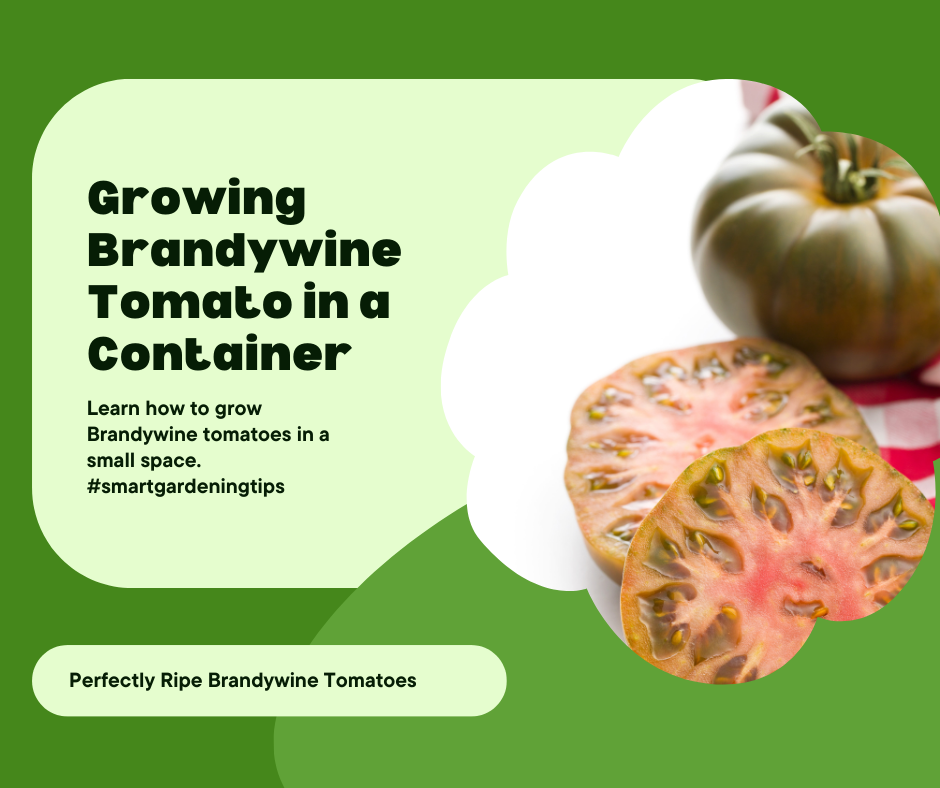
The Brandywine tomato is a remarkable variety known for its exceptional flavor and large fruit size. If you’re a tomato enthusiast seeking a delectable treat for your taste buds, the Brandywine tomato is a must-grow in your container garden. Let’s explore the unique characteristics that make this tomato variety a favorite among gardeners.
Taste Profile
The Brandywine tomato is celebrated for its rich, sweet, and slightly tangy flavor. Its succulent flesh offers a delightful blend of acidity and sweetness, making it a highly sought-after choice for enjoying fresh in salads or as a standalone snack.
Growth Habit
One of the distinguishing features of the Brandywine tomato is its vigorous growth habit. This indeterminate variety can reach impressive heights, often surpassing six feet in optimal growing conditions. The vigorous vines require sturdy support to ensure stability and proper fruit development.
Color Variations
The Brandywine tomato showcases a striking color palette that adds visual appeal to any dish. While the traditional variety displays a deep pink hue, you can also find yellow and black Brandywine tomato varieties, each offering subtly unique flavors and appearances.
Brandywine tomatoes are heralded for their exceptional flavor, impressive size, and vibrant color variations. Their taste profile, growth habit, and visual appeal make them a favorite among gardeners and tomato enthusiasts.
Brandywine Tomato Growing Techniques
To successfully cultivate Brandywine tomatoes in containers, it is important to employ the right growing techniques. These techniques will ensure optimal growth and a bountiful harvest of flavorful Brandywine tomatoes. In this section, we will provide you with expert advice on soil preparation, pruning, support methods, and other important considerations to help you achieve success in growing Brandywine tomatoes in containers.
Soil Preparation:
Brandywine tomatoes thrive in well-draining soil that is rich in organic matter. Begin by choosing a large container, at least 5 gallons in size, to allow ample space for the roots to grow. Fill the container with a high-quality potting mix that is specifically designed for vegetable gardening. Ensure the soil is loose and friable to promote healthy root development.
Pruning:
Brandywine tomatoes have vigorous growth and can become quite bushy. Pruning is essential to manage the plant’s size and encourage better air circulation, reducing the risk of diseases. Regularly pinch off suckers (small shoots that develop in the leaf axils) to channel the plant’s energy into fruit production and maintain a more manageable size.
Support Methods:
Due to their indeterminate growth habit, Brandywine tomatoes benefit from sturdy support structures. Use tomato cages, stakes, or trellises to provide stability and prevent the plant from sprawling or breaking under the weight of the fruit. Secure the plants to the support structure as they grow, using soft ties or clips to avoid damaging the stems.
Watering and Nutrient Needs:
Brandywine tomatoes require consistent moisture throughout the growing season. Water the plants deeply once or twice a week, ensuring the soil is evenly moist but not waterlogged. Mulching around the base of the plant will help retain soil moisture and prevent weed growth. Additionally, feed your Brandywine tomatoes with a balanced organic fertilizer every few weeks to provide essential nutrients for healthy growth and fruit production.
| Growing Technique | Description |
|---|---|
| Soil Preparation | Choose a large container and fill it with well-draining soil rich in organic matter. |
| Pruning | Regularly remove suckers to manage plant size and promote better air circulation. |
| Support Methods | Provide sturdy support structures such as cages, stakes, or trellises to prevent sprawling. |
| Watering and Nutrient Needs | Water deeply, mulch, and fertilize regularly to ensure consistent moisture and nutrient supply. |
Roma Tomato: Best Soil and Watering Practices
The Roma tomato is a versatile and prolific container variety that is highly suitable for making sauces and pastes. To ensure healthy Roma tomato plants and a plentiful harvest, it is crucial to provide them with the best soil type, watering practices, and fertilization techniques.
Soil Type
For optimal growth and development, Roma tomatoes prefer well-draining soil that is rich in organic matter. A loamy soil with a pH level between 6.0 and 6.8 is ideal. This type of soil allows for proper root development and nutrient absorption, leading to robust and healthy plants.
Watering Practices
Proper watering is essential to prevent under or overwatering, both of which can negatively impact Roma tomato plants. To determine when to water, check the top inch of soil. If it feels dry to the touch, it’s time to water.
When watering, aim for deep, thorough irrigation. This encourages the development of a strong root system. Avoid frequent shallow watering, as it can lead to weak root growth and susceptibility to diseases.
Furthermore, it’s important to water the base of the plant and avoid wetting the leaves. This helps prevent fungal diseases and ensures water reaches the plant’s root zone where it is most needed.
Fertilization Techniques
To provide essential nutrients for optimal growth, it is recommended to fertilize Roma tomato plants regularly throughout the growing season. Start by incorporating organic compost or well-rotted manure into the soil before planting.
During the growing season, use a balanced slow-release fertilizer that is specifically formulated for tomatoes. Follow the package instructions for application rates and frequency.
By following these best soil and watering practices, you can ensure that your Roma tomato plants thrive and produce a bountiful harvest of delicious tomatoes that are perfect for sauces, pastes, and a variety of culinary creations.
Roma Tomato Disease Resistance and Common Issues
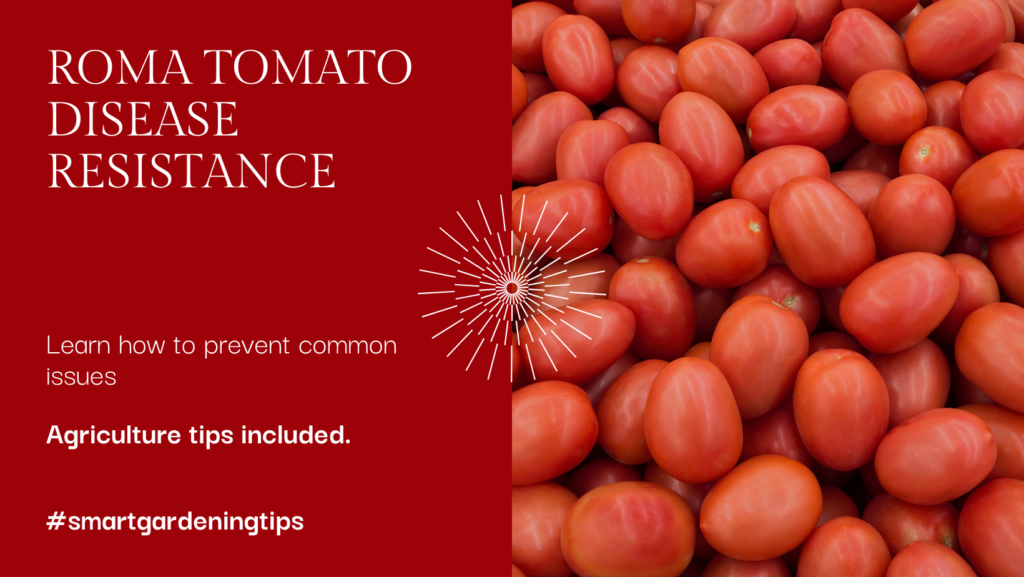
While Roma tomatoes are generally hardy and reliable, they can still be susceptible to certain diseases and issues that can impact their growth and productivity. It’s important to be aware of these common problems so you can take appropriate measures to protect your Roma tomato plants and ensure a successful harvest.
Common Issues with Roma Tomatoes
Here are some of the common issues that you may encounter when growing Roma tomatoes:
- Leaf Spot: Leaf spot is a fungal disease that causes dark spots to develop on the leaves of the tomato plant. It can weaken the plant and affect fruit production. To prevent leaf spot, make sure to water the plants at the base and avoid wetting the leaves. Remove any infected leaves and dispose of them properly.
- Blossom End Rot: Blossom end rot is a physiological disorder characterized by dark, sunken spots on the bottom of the tomato fruit. It is caused by a calcium deficiency in the plant. To prevent blossom end rot, maintain consistent moisture levels in the soil and ensure proper calcium uptake by maintaining adequate soil pH.
- Verticillium Wilt: Verticillium wilt is a soil-borne fungal disease that causes yellowing and wilting of the leaves. The fungus can persist in the soil for long periods, so it’s important to rotate crops and avoid planting tomatoes in areas where susceptible plants have grown in the past.
- Tomato Hornworm: Tomato hornworm is a common pest that can cause significant damage to tomato plants, including Roma tomatoes. These large green caterpillars can eat through leaves and fruit, reducing yield. Handpicking the caterpillars and applying organic pest control methods can help keep them at bay.
It’s important to monitor your Roma tomato plants regularly for any signs of disease or pest infestation. Early detection and proper treatment can help minimize the impact of these issues and ensure the health of your plants.
Disease Resistance in Roma Tomatoes
While no tomato variety is completely immune to all diseases, some Roma tomato cultivars exhibit better disease resistance than others. When selecting Roma tomato seeds or seedlings, look for varieties that have been bred for disease resistance.
Here are some Roma tomato varieties known for their disease resistance:
| Variety | Disease Resistance |
|---|---|
| Roma VF | Verticillium wilt, Fusarium wilt |
| Viva Italia | Fusarium wilt, Verticillium wilt |
| Amish Paste | Fusarium wilt, Verticillium wilt, Tomato mosaic virus |
By choosing disease-resistant Roma tomato varieties and implementing proper growing practices, such as crop rotation, maintaining soil health, and practicing good garden hygiene, you can minimize the risk of diseases and enjoy a successful harvest.
Overall, with knowledge of common issues, disease resistance, and preventive measures, you can grow healthy and thriving Roma tomato plants, ensuring a bountiful harvest of delicious tomatoes.
Patio Princess Tomato: Container Size and Placement
When it comes to growing the Patio Princess tomato, selecting the right container size and placement is essential for ensuring optimal growth and productivity. This compact tomato variety is specifically bred for container gardening, making it a perfect choice for small spaces like patios, balconies, or even windowsills. Follow our guidelines below to give your Patio Princess tomato plant the best possible start.
Container Size
To provide enough room for the Patio Princess tomato’s root system to develop and allow for proper nutrient uptake, choosing a container of the appropriate size is crucial. A container with a capacity of at least 5 gallons (19 liters) is recommended for individual plants. This size will accommodate the root growth, prevent the plant from becoming root-bound, and promote healthy foliage and fruit production.
Remember to consider the mature size of the Patio Princess tomato plant when deciding on the container size. While this variety stays relatively compact, reaching a height of around 2 to 3 feet (60 to 90 centimeters), its branches may spread out, especially when laden with ripe, juicy tomatoes. Providing sufficient space in the container will prevent crowding and ensure that each plant has enough room to thrive.
Placement
Proper placement of your Patio Princess tomato container is crucial for its overall health and productivity. Ensure that the location receives a minimum of six hours of direct sunlight every day. This will allow the plant to photosynthesize efficiently, leading to robust growth and flavorful tomatoes.
When choosing a spot for your container, consider not only the sunlight requirements but also the environmental conditions. Avoid areas with excessive wind or extreme temperature fluctuations, which can stress the plant and hinder its growth. You may need to provide some form of protection, such as wind barriers or shade cloth, if your chosen location is prone to these conditions.
Furthermore, take into account the convenience of access when deciding on the placement of your Patio Princess tomato container. Easy accessibility will make caring for the plant, including watering, pruning, and harvesting, much more enjoyable and convenient.
Remember to monitor the moisture levels regularly and ensure proper drainage to prevent waterlogged soil. Adequate air circulation around the plant is also crucial in preventing diseases.
By selecting the right container size and choosing an ideal placement for your Patio Princess tomato plant, you will set the stage for a bountiful harvest of delicious and vibrant tomatoes. Following these guidelines will help you create an optimal environment for the plant’s growth, allowing you to enjoy the rewards of container gardening on your patio or balcony.
Patio Princess Tomato: Pruning and Support Methods
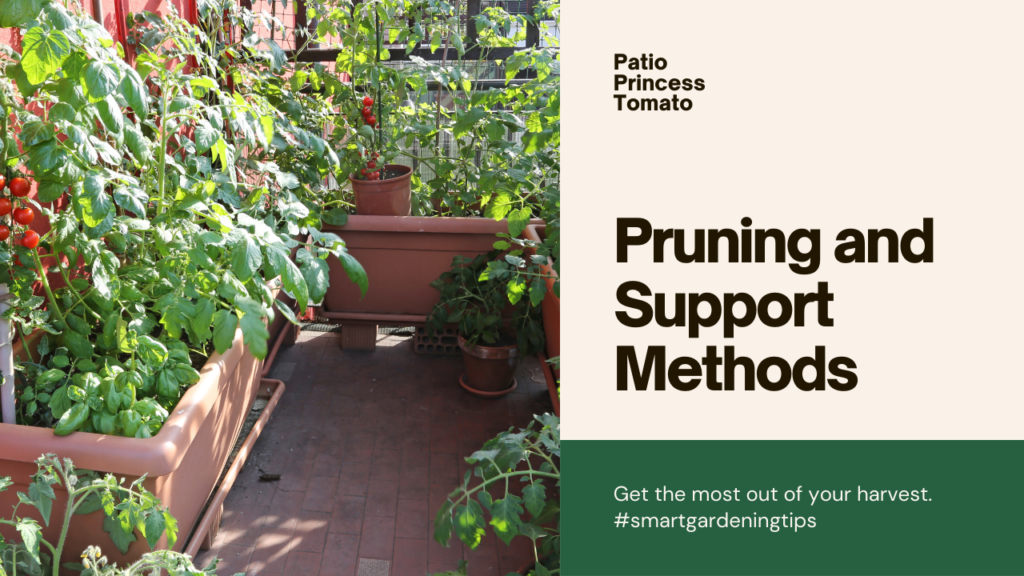
Proper pruning and support methods are essential for maintaining the health and productivity of your Patio Princess tomato plant. By following these step-by-step instructions, you can ensure that your plant thrives and produces an abundant crop of delicious tomatoes.
Pruning Your Patio Princess Tomato Plant
Pruning your Patio Princess tomato plant helps create a well-structured plant and prevents overcrowding, improving air circulation and reducing the likelihood of disease. Follow these pruning steps:
- Begin pruning when your plant reaches about 12 inches in height.
- Identify the main stem, also known as the central leader, and remove any suckers that grow from the leaf axils.
- Continue removing suckers as they appear, focusing on the lower part of the plant.
- Prune away any yellowing or diseased leaves to maintain plant health.
Remember to use clean and sharp pruning shears to avoid damaging the plant.
Supporting Your Patio Princess Tomato Plant
Providing adequate support for your Patio Princess tomato plant helps prevent branches from breaking under the weight of the fruit and ensures efficient use of space. Use the following methods to support your plant:
- Place a sturdy trellis or cage near the plant at the time of planting.
- Gently tie the main stem to the trellis or cage using soft plant ties or garden twine.
- As the plant grows, continue tying the branches to the support structure at regular intervals.
- Ensure that the support structure is securely anchored to prevent it from toppling over.
| Pruning and Support Benefits | Method |
|---|---|
| Promotes airflow and reduces disease risk | Regular pruning to remove suckers and yellowing leaves |
| Prevents branch breakage | Using a trellis or cage to support the plant |
| Optimizes space utilization | Pruning and tying branches to the support structure |
Following these pruning and support methods will help your Patio Princess tomato plant flourish, resulting in a bountiful harvest of juicy, flavorful tomatoes. Happy gardening!
Cherry Tomato Varieties: Sunlight and Temperature Requirements
Cherry tomatoes are a delightful addition to any garden or container, offering a burst of flavor in compact, bite-sized fruits. Each cherry tomato variety has specific preferences when it comes to sunlight and temperature. Understanding these requirements is key to growing healthy and productive cherry tomato plants.
Sunlight Requirements
Cherry tomato plants thrive in sunny locations, requiring at least 6-8 hours of direct sunlight per day. Adequate sunlight ensures vigorous growth, promotes fruit development, and enhances the overall flavor of the tomatoes. For optimal results, place your cherry tomato containers in areas that receive ample sunlight throughout the day.
Temperature Requirements
Temperature plays a significant role in the growth and fruiting of cherry tomatoes. Most varieties prefer warm temperatures, typically between 70-85°F (21-29°C), to thrive. These warm temperatures encourage faster growth and ripening of the fruits.
However, it’s important to consider the specific requirements of the cherry tomato variety you are growing. Some varieties are more tolerant of cooler temperatures, while others may require additional heat. Here’s a quick overview of temperature preferences for commonly grown cherry tomato varieties:
| Cherry Tomato Variety | Temperature Range |
|---|---|
| Red Cherry | 60-80°F (15-27°C) |
| Sweet 100 | 70-85°F (21-29°C) |
| Sungold | 75-90°F (24-32°C) |
| Rainbow Blend | 60-85°F (15-29°C) |
Remember to provide adequate protection for your cherry tomato plants during colder temperatures. Consider using cloches, row covers, or bringing the containers indoors during frosty conditions. This will help extend the growing season and prevent damage to the plants.
By understanding the sunlight and temperature requirements of different cherry tomato varieties, you can create optimal growing conditions and enjoy a bountiful harvest of delicious, colorful fruits.
Cherry Tomato Varieties: Pests and Pest Management
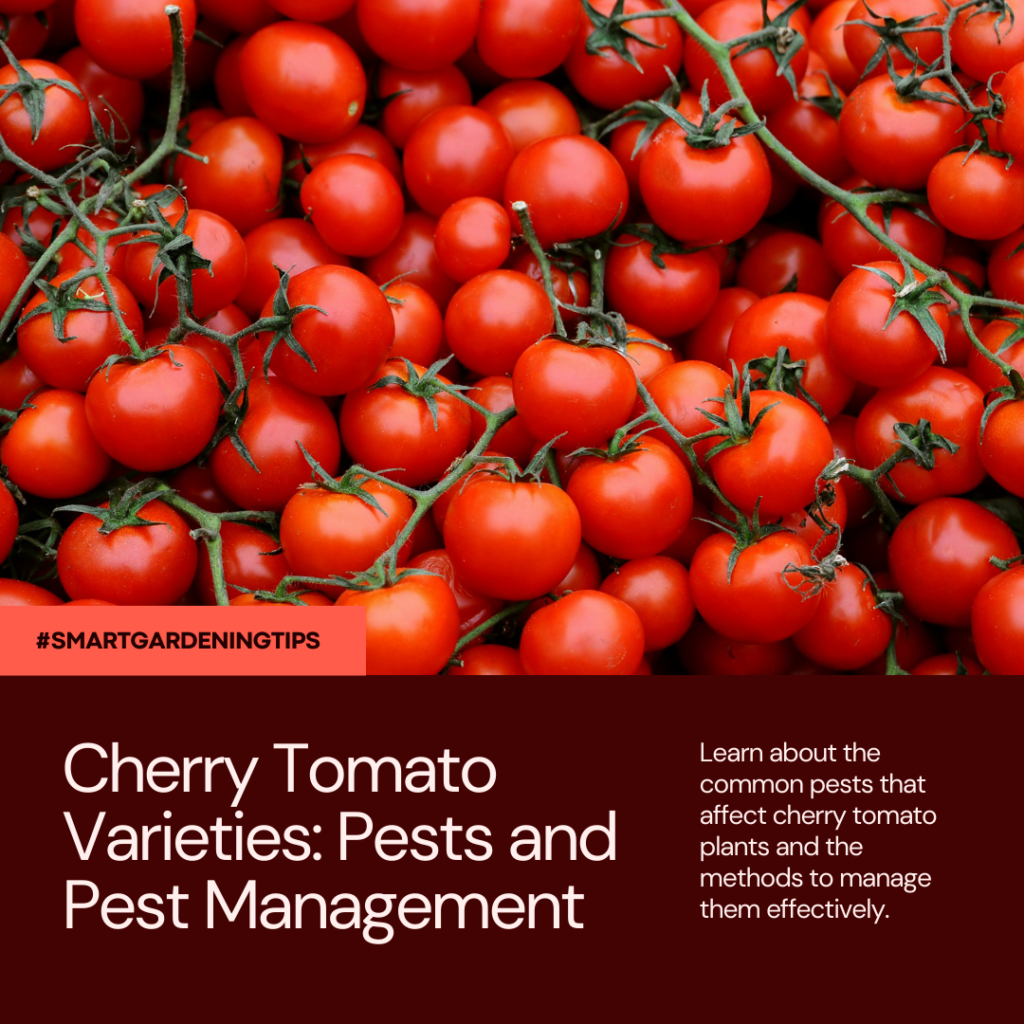
Pests can be a common challenge when growing cherry tomatoes in containers. To ensure the health and vitality of your plants, it’s important to be aware of the pests that can affect them and implement effective pest management strategies. Here, we will discuss some of the common pests that can impact cherry tomato plants and provide you with practical methods to control them.
Common Pests
Here are some of the most common pests that can infest cherry tomato plants:
- Aphids: These tiny insects feed on the sap of the plants, causing stunted growth and distorted leaves.
- Whiteflies: These small white insects can rapidly multiply and suck the sap from the leaves, resulting in yellowing, wilting, and reduced plant vigor.
- Spider Mites: These minuscule pests thrive in dry conditions and spin fine webs on the underside of leaves. They feed on plant juices, causing discoloration and leaf damage.
- Cutworms: These soil-dwelling caterpillars cut through stems at the base, leading to plant wilting and death.
- Hornworms: These large caterpillars can quickly strip the foliage of tomato plants, significantly impacting growth and yield.
Pest Management Strategies
To effectively manage pests in your cherry tomato containers, consider implementing the following strategies:
- Companion Planting: Interplanting your cherry tomatoes with pest-repelling companion plants like marigolds, basil, or mint can help deter pests.
- Regular Inspection: Regularly inspect your plants for signs of pest infestation, such as discolored leaves or insect activity.
- Handpicking: If you spot pests on your cherry tomato plants, manually remove them by handpicking or using a gentle spraying of water to dislodge them.
- Biological Controls: Introduce beneficial insects like ladybugs or lacewings to your containers, as they can prey on common pests.
- Organic Sprays: Consider using organic sprays or insecticidal soaps to control pests if the infestation is severe and other methods have been ineffective.
- Proper Hygiene: Keep your containers and the surrounding area clean, removing any fallen leaves or debris that could harbor pests.
By implementing these pest management strategies, you can prevent or minimize pest damage to your cherry tomato plants, ensuring a healthy and productive container garden.
| Pest | Description | Pest Management |
|---|---|---|
| Aphids | Small insects that feed on sap, causing stunted growth and distorted leaves. | – Introduce ladybugs or lacewings, which are natural predators of aphids. – Use insecticidal soap or neem oil spray to control aphids. – Keep plants well-watered and fertilized to promote plant health and resilience to aphid infestations. |
| Whiteflies | Small white insects that suck sap from leaves, leading to yellowing, wilting, and reduced plant vigor. | – Hang yellow sticky traps near plants to capture adult whiteflies. – Introduce natural predators like Encarsia wasps or ladybugs to control whiteflies. – Apply insecticidal soap or neem oil spray to control whiteflies. |
| Spider Mites | Microscopic pests that feed on plant juices, causing discoloration and leaf damage. | – Regularly spray plants with a strong stream of water to dislodge spider mites. – Introduce predatory mites, such as Phytoseiulus persimilis, which feed on spider mites. – Apply insecticidal soap or neem oil spray to control spider mites. |
| Cutworms | Soil-dwelling caterpillars that cut through stems at the base, leading to plant wilting and death. | – Place collars made of cardboard or plastic around the base of plants to prevent cutworms from accessing them. – Handpick cutworms and dispose of them in soapy water. – Apply Bacillus thuringiensis (Bt) targeted to cutworm larvae. |
| Hornworms | Large caterpillars that can strip the foliage of tomato plants, impacting growth and yield. | – Handpick hornworms from plants and remove them manually. – Apply Bacillus thuringiensis (Bt) targeted to hornworm larvae. – Implement companion planting with marigolds or basil, as they repel hornworms. |
FAQ
Q. What are the recommended container tomato breeds?
A. The top-rated container tomato breeds include the Early Girl tomato, Brandywine tomato, Roma tomato, Patio Princess tomato, and various cherry tomato varieties.
Q. What are the ideal growing conditions for the Early Girl tomato?
A. The Early Girl tomato thrives in full sun (at least 6-8 hours of direct sunlight), well-draining soil with ample organic matter, and regular watering to keep the soil consistently moist.
Q. What are some tips for harvesting and storing Early Girl tomatoes?
A. Early Girl tomatoes should be harvested when they are fully ripe, just before they become overly soft. Store them in a cool and dry place away from direct sunlight, such as a basement or pantry.
Q. What are the unique characteristics of the Brandywine tomato?
A. The Brandywine tomato is renowned for its exceptional flavor, large fruit size, and pink or red color variations. It has a vine-like growth habit and typically requires staking or caging for support.
Q. What are the recommended growing techniques for Brandywine tomatoes in containers?
A. To grow Brandywine tomatoes in containers, use well-draining soil rich in organic matter, provide sturdy support for the plants, and prune to maintain good airflow. Regular fertilization is also important for optimal growth.
Q. What are the best soil and watering practices for Roma tomatoes?
A. Roma tomatoes thrive in well-draining soil with a slightly acidic pH level. Water deeply but infrequently, allowing the top inch of soil to dry out between watering sessions. Applying a layer of mulch can help retain moisture.
Q. What are some common diseases and issues that can affect Roma tomatoes?
A. Roma tomatoes can be susceptible to diseases such as blossom end rot, blight, and wilt. It is important to practice crop rotation, proper sanitation, and provide adequate airflow to minimize the risk of these issues.
Q. What container size and placement are recommended for Patio Princess tomatoes?
A. Patio Princess tomatoes thrive in containers that are at least 12-14 inches deep and wide. Place the containers in a location that receives a minimum of 6-8 hours of sunlight per day.
Q. How should Patio Princess tomatoes be pruned and supported?
A. Patio Princess tomatoes benefit from regular pruning to remove suckers and maintain a compact shape. Provide support such as tomato cages or stakes to prevent the plants from sprawling and to support the weight of the fruit.
Q. What are the sunlight and temperature requirements for cherry tomato varieties?
A. Most cherry tomato varieties require full sun (6-8 hours of direct sunlight) and prefer temperatures between 70-85°F (21-29°C). However, some varieties may tolerate slightly cooler or hotter temperatures.
Q. How can pests be managed in cherry tomato varieties?
A. Common pests that affect cherry tomato plants include aphids, whiteflies, and tomato hornworms. Implementing preventive measures such as regular inspection, handpicking pests, and using organic pest control methods can help manage these pests effectively.
Conclusion
In conclusion, container gardening offers a fantastic opportunity to grow an abundant supply of tomatoes, even in small spaces. With the right tomato varieties and proper growing techniques, you can experience the joy and satisfaction of harvesting your own fresh tomatoes right on your patio or balcony.
By selecting tomato breeds specifically suited for containers, such as the Early Girl, Brandywine, Roma, and Patio Princess, you can ensure successful growth and a fruitful harvest. These varieties have been carefully chosen for their compact size, adaptability to container gardening, and delicious flavor profiles.
Implementing proper care techniques, including providing adequate sunlight, using the appropriate soil type, and following watering and pruning practices, will contribute to the success of your container tomato garden. Regular monitoring for pests and diseases and taking proactive measures for prevention are also essential in maintaining healthy plants.
So why wait? Start your container tomato garden today and revel in the joy of harvesting your own homegrown, flavorful tomatoes. Whether you’re a seasoned gardener or a beginner, container gardening offers a convenient and rewarding way to enjoy the taste and freshness of homegrown produce. Happy gardening!
















